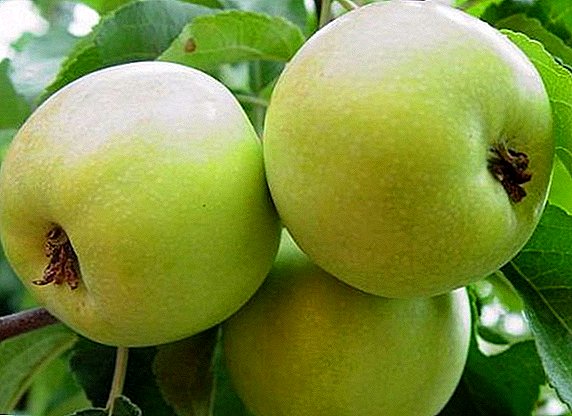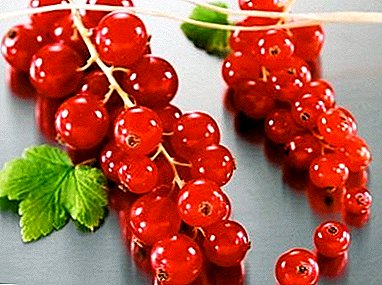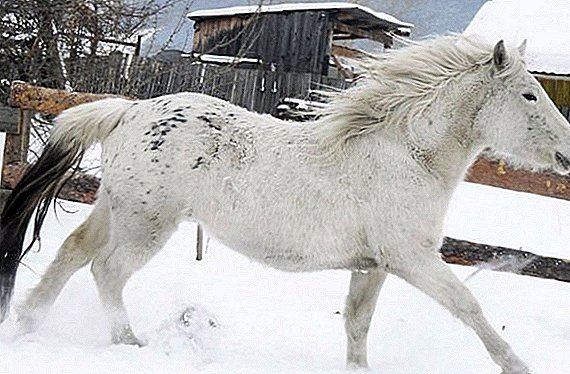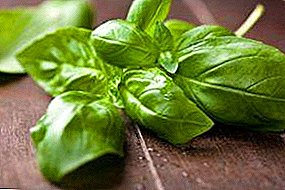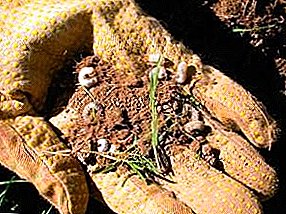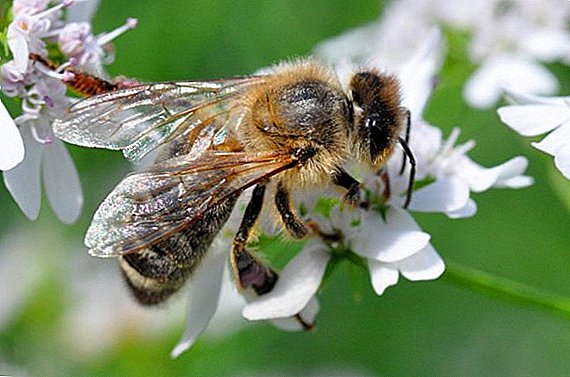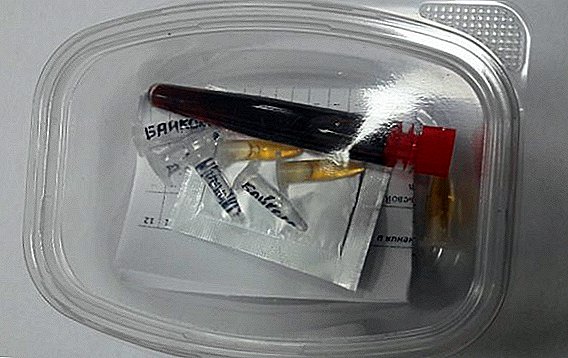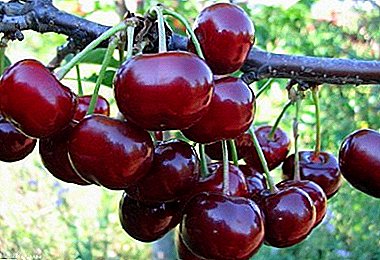
Aphid - one of the main pests of gardens, gardens and houseplants, it belongs to the order wing. In the world there are about 20 thousand species of aphids. They live on plants whose juice they feed on.
Their skin is thin, it easily evaporates moisture due to which these insects have to drink a lot. The excess nutrients obtained by aphids from the sap of plants, they emit in the form of "honey dew", which is very fond of ants.
Aphid lifestyle
 Aphids themselves are small insects, no larger than a few millimeters in size.. Their oval-shaped bodies are covered with a knobby, half-transparent shell. Thanks to the long legs, aphids can crawl and even jump from one plant to another. Read more about where the aphid lives and what the gardener and gardener need to know about the pest, read here.
Aphids themselves are small insects, no larger than a few millimeters in size.. Their oval-shaped bodies are covered with a knobby, half-transparent shell. Thanks to the long legs, aphids can crawl and even jump from one plant to another. Read more about where the aphid lives and what the gardener and gardener need to know about the pest, read here.
They live in colonies, and in each of these colonies there are wingless insects and individuals with wings. The sign of aatment in aphids is not related to sex: the wings are both in females and in males. On the head of an adult insect there are antennae, thanks to which it distinguishes sounds, also antennae are necessary for it to touch.
Eyes aphids with complex multi-faceted structure come in a variety of colors: from red to dark brown, almost black. In flightless insects can be in addition to them three simple ocelli.
The mouth opening of the aphid is a small proboscis consisting of four segments. She pierces the skin of the plant with them and sucks the juice out of it (for more details on what the aphids feed on, you can find out here). The leaves of plants affected by aphids begin to wither, shoots cease to grow, and on the roots hollow protrusions are formed - galls. Aphids can affect all parts of a plant., which makes it a particularly formidable and dangerous pest.
The life cycle of aphids begins with the fact that in the fall the female lays eggs, from which the larvae hatch in spring. As adults, they begin to multiply by the method of parthenogenesis, that is, without fertilization. At this stage, the progeny of aphids are only wingless females. In a month their number can reach hundreds of thousands.
As soon as the colony is overcrowded, among the offspring individuals appear with wings that can fly to other plants. In late summer, winged males appear among the progeny of aphids..
When they become adults, individuals of both sexes already participate in reproduction. The female now lays much less eggs. But fertilized eggs will be able to transfer the winter, whereas all the aphids, hatched from the first, not fertilized clutches, do not live up to the cold.
Aphids can live from a few days to a month.. Cool temperature, 8-10 ° С prolongs the life of the female up to two months.
How do ants live?
 Ants belonging to the order of Hymenoptera live in nests built by them - anthills, arranged in the ground, under stones or in wood. Often, along with them, there are other insects that have entered into a symbiosis with ants.
Ants belonging to the order of Hymenoptera live in nests built by them - anthills, arranged in the ground, under stones or in wood. Often, along with them, there are other insects that have entered into a symbiosis with ants.
In addition to the host ants, the “slaves” captured by them sometimes live in anthills — ants from other colonies doing the hardest work.
Ants are small insects, their numbers are huge because they reproduce very quickly. They live everywhere except for Antarctica and several islands lost in the world ocean.
An ant colony is a complex structure with a division into castes:
- Ant females - Also called queen or queen are engaged only in the reproduction of offspring. Males are bred from non-fertilized eggs, and females from fertilized eggs. The queen has wings, but she bites them off immediately upon completion of the flight. Uterus ants are much larger than their "subordinates" and live longer than them. The life of an ant queen can reach 20 years or more.
- Ant males - they are smaller than the uterus, and they also have wings. Their only task is to participate in pairing. After the males fulfill their purpose, they are destroyed by other ants. The life of ants males reaches several weeks.
- Working ants or foragers - These are females with an underdeveloped reproductive system. They get food, maintain order in the anthill and raise future offspring. The largest individuals among the workers' ants with a large head and strongly developed jaws, which are called soldiers ants, protect the anthill from uninvited guests.
Ants are considered beneficial insects, but when they settle near a person, they cause considerable harm.
Important! Ants damage garden and garden plants, as well as grasses, undermine the walls of wooden houses and sheds from inside and help to reproduce unhindered, which makes it very difficult to fight it.
Insect symbiosis: why do they need each other?
 Ants bring aphids and plant them on leaves of garden or garden crops.. Absorbing the sap of the plant, leaf aphid receives proteins, and sugar removes from its body in the form of sweet drops, called paddy or honeydew.
Ants bring aphids and plant them on leaves of garden or garden crops.. Absorbing the sap of the plant, leaf aphid receives proteins, and sugar removes from its body in the form of sweet drops, called paddy or honeydew.
What is the essence of the insect union, how do ants milked the symbiont (aphids) and do they eat it themselves? The ant tickles the whining with the antennae, and it emits a drop of sweet liquid. Some aphids almost every minute emit a drop of honeydew.
For this, the ants graze or protect the aphids from ladybirds, gold-eyed birds and birds, and even build clay shelters for them on the stalks of plants, and also transfer the aphids to other, younger and more succulent plants after the diseased plant begins to wilt.
For the winter, the ants even take the aphids into their anthills.where all winter they take care of her and the eggs laid by her.
How to fight?
Garden ants lodge in the dacha and backyard plots, which spoil the harvest and plant countless hordes of aphids.
There are many anti-ants chemicals., the main action of which is directed primarily to the paralysis of the nervous system of these insects. The basis of most of them is diazinon or chlorpyrifos.
Fighting ants can also be done in more “environmentally friendly” ways: spread anise leaves or sawdust mixed with grated garlic around the anthill. Or pour it with kerosene, but do not set it on fire.
Attention! Good effect gives the usual salt: it should be poured on the nest itself and the paths along which these insects move.
Wormwood and parsley growing on the plot will also protect against antswho do not tolerate the smell of these herbs.
Vegetable oil, tobacco ash, crushed leaves of tomatoes, as well as turpentine and charcoal are also good means against them.
But due to the fact that the greatest harm to the garden and the garden is applied to the ants, and aphid, first of all, you need to deal with it. There are several ways to do this. The most popular methods of struggle - mechanical or manual.. You can also use chemicals that destroy aphids.
You can also plant plants around the garden or garden that attract natural leaf aphid enemies, such as ladybugs, hoverflies, golden-eyed birds and various birds.
Read more about other helpers in the fight against aphids read in this material.
How to protect the trees?
Tree protection can be done in several ways.:
 Put trapping belts of several layers of corrugated cardboard or polyethylene film on the stumps of trees, tying them in two places with a soft rope and putting a strip of grease around the perimeter in the central part.
Put trapping belts of several layers of corrugated cardboard or polyethylene film on the stumps of trees, tying them in two places with a soft rope and putting a strip of grease around the perimeter in the central part.- Dig a shallow hole along the perimeter of the tree and lay in it a car tire cut in half filled with water.
- Grate the tree trunks with garlic arrows, the smell of which the ants cannot stand.
- Coil wormwood grass or tomato tops.
- Contact the nearest SES in order for the disinsection specialists to process the trees themselves, as well as the nearest plantings and anthills.
- How to get rid of aphids on orchids at home?
- How to get rid of aphids on pepper?
- What to do if aphid started up on roses?
- How is the struggle with aphids on fruit trees?
- How to deal with aphids on cucumbers?
- How to effectively deal with aphids on currants?
- How to deal with white aphids on indoor and garden plants?
This type of relationship as a symbiosis between ants and aphids exists for millions of years - these insects are so much dependent on each other that they could not survive alone. In the event that aphid appeared on the plot, it is necessary to simultaneously fight against both of them. If you do not fight other than aphids and more with ants, then the leaves of the plants will soon again be littered with these pests.


 Put trapping belts of several layers of corrugated cardboard or polyethylene film on the stumps of trees, tying them in two places with a soft rope and putting a strip of grease around the perimeter in the central part.
Put trapping belts of several layers of corrugated cardboard or polyethylene film on the stumps of trees, tying them in two places with a soft rope and putting a strip of grease around the perimeter in the central part.